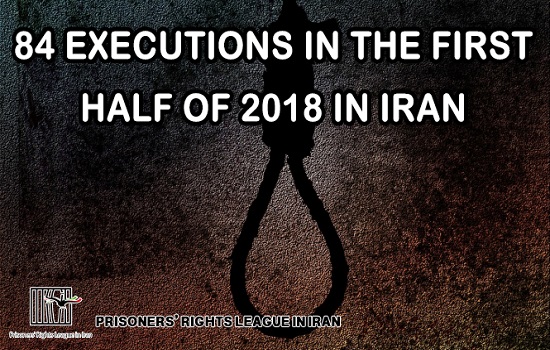The Report of 84 Executions during the First Half of 2018 in Iran

19-August-2018
Category: executions
Breathing in Confinement – The Islamic Republic of Iran has always been criticized by the International Community and human rights organizations for the high number of executions in Iran.
Since 2012 that Hassan Rouhani has taken the office by promises such as respecting the civil rights, the situation of the human rights in Iran has deteriorated in many aspects.
Prisoners’ Rights League in Iran (PRLI) had previously published a report about 2814 executions during Hassan Rouhani’s first term in office.
Whereas there had been 1095 executions in Mahmoud Ahmadinejad’s first period of presidency and 2236 execution during his second term.
Because of international pressures and the efforts of human rights organizations and defenders in Iran, the Islamic Parliament of Iran finally passed the bill of the new Law of Combating Drugs on October 4, 2017. The bill was enforced on November 14, 2017 which reduced the number of executions on drug offences which used to be the highest portion of executions in Iran.
Despite being a significant victory for human rights defenders in Iran, this was a first step in abolishing death penalty in the country.
The Islamic Republic of Iran has continued to execute dozens of prisoners across the country in 2018.
According to the report of the Center of Statistics of Prisoners’ Rights League in Iran, at least 84 people have been executed during the first half of 2018 in Iran.
Despite on-going criticism, Iran continues to carry out death penalties in public. During the first 6 months of 2018, at least 6 people have been executed in public in the cities of Salmas, Dogonbadan, Mashhad and Bandar Abbas.
The prisoners have been executed in public regardless of the presence of the children at the scene and after a governmental campaign of calling on the people to watch the execution. The public execution is in fact a mass-punishment for all of those who see the scene and carries a whole different level of violence in carrying out death penalties.
One of the main concerns about the executions in Iran is that many of them are being carried out secretly or remain undisclosed by the government. This indicates the importance of independent reporting by the human rights organizations and defenders.
The state-run media have only reported 25 executions from January to the end of June 2018 and the rest have been reported by independent human rights defenders. This shows a strong tendency among the Iranian authorities to hide the executions.
This raises the concerns about the possibility of more hidden executions in Iran and a much higher number of executed prisoners in 2018 as well.
Despite strong criticism by the international organizations, the Islamic Republic of Iran executes inmates who were juveniles at the time of committing the crime. Iran is one of the few countries in the world which execute juvenile offenders and at least 4 juvenile offenders have been executed during the first half of 2018 in Iran.
Amir Hossein Pourjafar, Mahboubeh Mofidi, Ali Kazemi and Abolfazl Chezani were the 4 prisoners whom had been arrested as juveniles and were executed after reaching 18 years of age.
89% of the prisoners were executed on charge of murder and based on the Rule of Retaliation which points out the vital need of reform in the Iranian penal code.
The death penalty in Iran is not just being used for cruel crimes or drug offences but it has been a tool of repressing the dissenters and political opponents.
The first half of 2018 was no exception in this regard and Mohammad Salas a Gonabadi Dervish who had been arrested during the raid of the security forces to the house of the Dervishes’ Qutb in 7th Golestan Street in Tehran, was executed on June 18th.
His execution which was condemned widely by the international organizations was the end of an unjust and unclear due process. Mohammad Salas had stated several times that he was innocent.
Click here to download the PDF of this report: The Report of 84 Executions during the First Half of 2018 in Iran
